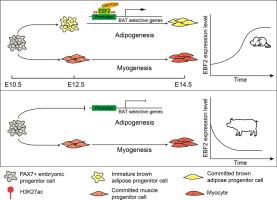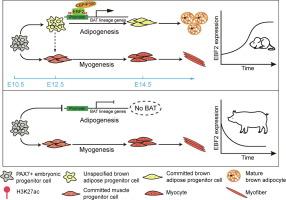小鼠(而非猪)中EBF2的升高通过染色质激活驱动褐色脂肪谱系的进行性规范
IF 13
1区 综合性期刊
Q1 MULTIDISCIPLINARY SCIENCES
引用次数: 0
摘要
褐色脂肪组织(BAT)负责非寒战产热,但在一些哺乳动物中不存在,包括猪。在发育过程中,BAT祖细胞来源于表达配对box 7 (Pax7)的体细胞中胚层干细胞,它也产生骨骼肌。然而,棕色脂肪和肌肉祖细胞之间命运决定的内在机制仍然难以捉摸。在这项研究中,我们分析了Pax7+祖细胞分离棕色脂肪和肌肉谱系的过程中染色质景观的动态,旨在揭示驱动BAT形成的表观遗传因素。值得注意的是,肌源性祖细胞在胚胎日(E) 12.5时被指定,在肌肉相关基因上表现出高水平的H3K4me3和低水平的H3K27me3。相比之下,BAT谱系的确定要晚得多,从E10.5到E14.5, BAT相关基因的组蛋白修饰协调地逐步沉积。我们发现早期b细胞因子2 (EBF2)是棕色脂肪谱系逐步规范的关键驱动因素。在机制上,EBF2与转录共激活因子CREB结合蛋白/ e1a结合蛋白p300 (CBP/ p300)相互作用,诱导bat相关基因的染色质乙酰化,促进棕色脂肪的形成。小鼠和猪的Ebf2都能有效刺激未指明的多能中胚层干细胞的脂肪生成。然而,在猪中,EBF2的表达在关键谱系规范时间窗期间被耗尽,从而阻止了BAT的胚胎发育。因此,小鼠(而非猪)中EBF2的升高可促进染色质激活,从而推动棕色脂肪谱系的逐步规范。本文章由计算机程序翻译,如有差异,请以英文原文为准。


Elevated EBF2 in mouse but not pig drives the progressive brown fat lineage specification via chromatin activation
Brown adipose tissue (BAT) is responsible for non-shivering thermogenesis, but it is absent in some mammals, including pigs. During development, BAT progenitors are derived from paired box 7 (Pax7)-expressing somitic mesodermal stem cells, which also give rise to skeletal muscle. However, the intrinsic mechanisms underlying the fate decisions between brown fat and muscle progenitors remain elusive across species. In this study, we analyzed the dynamics of chromatin landscape during the segregation and specification of brown fat and muscle lineages from Pax7+ multipotent mesodermal stem cells, aiming to uncover epigenetic factors that drive de novo BAT formation. Notably, myogenic progenitors were specified at embryonic day (E) 12.5, exhibiting high levels of H3K4me3 and low H3K27me3 at muscle-related genes. In contrast, the specification of the BAT lineage occurred much later, with coordinated step-wise depositions of histone modifications at BAT-associated genes from E10.5 to E14.5. We identified the transcription factor early B-cell factor 2 (EBF2) as a key driver of the progressive specification of brown fat lineage and the simultaneous deviation away from the muscle lineage. Mechanistically, EBF2 interacts with transcriptional co-activators CREB binding protein/ E1A-binding protein p300 (CBP/P300) to induce H3K27ac deposition and chromatin activation at BAT-associated genes to promote brown adipogenesis. Both mouse and pig EBF2 could potently stimulate adipogenesis in unspecified multipotent mesodermal stem cells. However, in pigs, EBF2 expression was depleted during the critical lineage specification time window, thus preventing the embryonic formation and development of porcine BAT. Hence, the elevation of EBF2 in mice, but not in pigs, promote chromatin activation to drive the progressive specification of brown fat lineage.
求助全文
通过发布文献求助,成功后即可免费获取论文全文。
去求助
来源期刊

Journal of Advanced Research
Multidisciplinary-Multidisciplinary
CiteScore
21.60
自引率
0.90%
发文量
280
审稿时长
12 weeks
期刊介绍:
Journal of Advanced Research (J. Adv. Res.) is an applied/natural sciences, peer-reviewed journal that focuses on interdisciplinary research. The journal aims to contribute to applied research and knowledge worldwide through the publication of original and high-quality research articles in the fields of Medicine, Pharmaceutical Sciences, Dentistry, Physical Therapy, Veterinary Medicine, and Basic and Biological Sciences.
The following abstracting and indexing services cover the Journal of Advanced Research: PubMed/Medline, Essential Science Indicators, Web of Science, Scopus, PubMed Central, PubMed, Science Citation Index Expanded, Directory of Open Access Journals (DOAJ), and INSPEC.
 求助内容:
求助内容: 应助结果提醒方式:
应助结果提醒方式:


